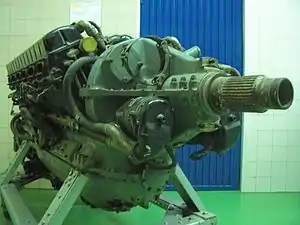Hispano-Suiza 12Z
The 12Z, designated Type 89 by the company, was the final evolution of the series of Hispano-Suiza V-12 aircraft engines. The Z model had just entered production when France fell to the Germans during World War II. A small number were produced during the war but the German occupation government would not allow full-scale production to start. After the war small numbers were built to equip new designs, but the rapid introduction of the jet engine ended further development.
| Hispano-Suiza 12Z | |
|---|---|
 | |
| Type | V-12 liquid-cooled piston engine |
| National origin | France |
| Manufacturer | Hispano-Suiza |
| Major applications |
|
| Developed from | Hispano-Suiza 12Y |
Design and development
The 12Z differed from the earlier 12Y primarily in the use of four valves per cylinder operated by dual overhead cams, as opposed to two valves operated by a single camshaft. This gave the cylinders considerably better volumetric efficiency and faster operation, raising the RPM from 2,400 to 2,700. The engine was also designed to run only on 100 octane fuel (instead of 87, which was common at that point) which allowed the compression ratio to rise from the 12Y's 5.8:1 to the 12Z's 6.75:1. These changes raised the power from 1,000 to 1,300 hp (750 to 970 kW) at sea level.
The engine continued to use a single-stage, single-speed supercharger and therefore lacked the all-altitude performance of German and British designs. But tuning the supercharger for a different critical altitude improved high-altitude performance considerably, delivering 1,500 hp (1,120 kW) at 6,400 m (21,000 ft) as opposed to 930 hp (690 kW) at 900 m (3,000 ft) for the 12Y.
Small prototype runs started in 1939, and were fitted to the French Air Force's front-line fighter aircraft, the M.S.410 and D.520, creating the M.S.450 and D.524 respectively. Production of the main model, the 12Z-17, was just starting at the time of the armistice. Production was undertaken in Hispano-Suiza's Spanish factories where they were intended for the Hispano Aviación HA-1112 - only a few were ever used, however, because of mechanical problems with the engine.
After the war a new version tuned to operate with 92 octane fuel, as opposed to the -17's 100/130, was built in limited numbers as the 12Z-89. Compression ratio was raised slightly to 7:1, but with the lower grade fuel the power dropped slightly to 1,280 hp (950 kW) at 2,600 rpm (1,479 hp (1,100 kW) maximum take-off). These engines apparently had the same sorts of reliability issues as the earlier -17's made in Spain, and the type never entered production.
Variants
- 12Z-1
- The initial version of the engine used for development
- 12Z-17
- development peak at time of the Fall of France in May 1940
- 12Z-89
- post-war development, not successful.
Applications
- Breguet 482
- Hispano Aviación HA-1112
- Ikarus S-49C
Specifications (12Z-1)
Data from [1]
General characteristics
- Type: V-12 60° liquid-cooled, gear driven supercharged four stroke piston engine
- Bore: 150mm (5.9in)
- Stroke: 170mm (6.69in)
- Displacement: 36.05 litres (2,199.9 cu in)
- Length: 2,384mm (93.8in)
- Width: 744mm (29.3in)
- Height: 1,074mm (42.3in)
- Dry weight: 620kg (1,367lb)
- Hollow propeller shaft to accommodate a cannon barrel
Components
- Valvetrain: Two intake and two sodium-cooled exhaust valves per cylinder actuated by dual overhead camshafts
- Supercharger: Gear-driven single-stage two-speed centrifugal type supercharger with automatic boost control - ratios 6.36:1 and 9.38:1
- Fuel system: Direct fuel injection @ 40 kgf/cm² (570 psi) 2x Lavalette P511-AS2 6-plunger injection pumps with 1x Lavalette KFD injector per cylinder
- Fuel type: 100/130-octane rating gasoline
- Oil system: Dry sump, pressure feed @ 5 kgf/cm² (70 psi), 20.5 centistokes (100 S.U. secs) viscosity oil
- Cooling system: Ethylene Glycol/water mix
- Reduction gear: Spur reduction gear ratio 0.6:1
- Air Equipment 1525 compressed gas starting system
Performance
- Power output:
- Take-off - 1,342kW (1,800hp) @ 1,150mm (45.3in)Hg boost @ 2,800rpm
- Military, low - 1,193kW (1,600hp) @ 2,500m (8,200ft) @ 2,800rpm
- Military, high - 984kW (1,320hp) @ 8,000m (26,200ft) @ 2,800rpm
- Cruising, low - 1,193kW (900hp) @ 3,000m (9,800ft) @ 2,100rpm
- Cruising, high - 1,193kW (900hp) @ 5,600m (18,400ft) @ 2,100rpm
- Specific power: @ take-off power - 37.22kW/l (0.818hp/(cu in))
- Compression ratio: 7.0:1
- Specific fuel consumption: 0.29kg/(kW h) (0.48lb/(hp h))
- Oil consumption: 0.006 kg/(kW h) (0.018lb/(hp h))
- Power-to-weight ratio: @take-off power - 2.16kW/kg (1.32hp/lb)
- B.M.E.P. (Brake mean effective pressure) 16.3 kgf/cm² (232 psi)
See also
Related development
- Hispano-Suiza 12Y
- Klimov VK-100
- Klimov VK-103
- Klimov VK-104
- Klimov VK-105P
- Klimov VK-106
- Klimov VK-107
Related lists
References
- Wilkinson, Paul H. (1946). Aircraft Engines of the World 1946 (revised 3rd ed.). London: Sir Isaac Pitman & Sons Ltd.
External links
| Wikimedia Commons has media related to Hispano-Suiza 12Z. |
- "Hispano Suiza 12B" a 1949 Flight article